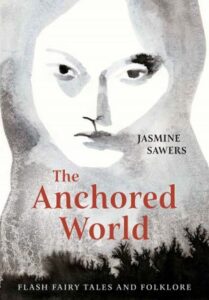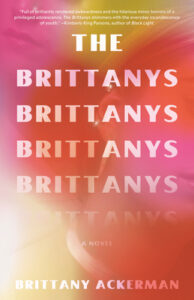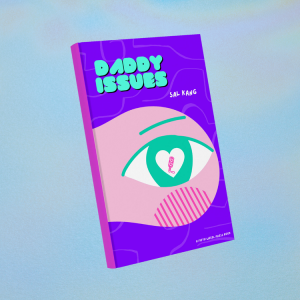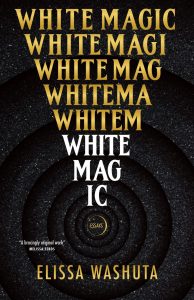Flash Fiction. 78 pgs. Rose Metal Press. October 2022. 978-1-941628-27-0.
In an author’s note at the end of The Anchored World, Jasmine Sawers explains her love of fairy tales—both Western and Thai—and how those stories have stayed with her since childhood. “Fairy tales,” she writes, “are often the first stories that will teach us what stories can do. Fairy tales made me a writer first for their fabulism, but then for their darkness.” In this collection, subtitled “Flash Fairy Tales and Folklore,” roughly a third have their roots in those ancient, oft-told stories, but Sawers does not retell nor interpret them; rather, she lets readers experience them through a pinhole or a cracked door; what we read is recognizable but only partly.
“Once Upon a Time in an Orchard,” for example, has Snow White as its origin story, but what we see of that familiar narrative is an orchard-keeper explaining that, “every apple in my orchard comes pre-poisoned for your convenience.” Further, we are told, these apples “fit just so into the palm of any delicate princess on the run.” Thanks to the keeper’s “simple genetic modification,” which conjures memories of childhood, these apples insure a bite will be taken. In a second take on Snow White, “Fairest,” Sawers uses the queen’s magic mirror to reveal the allure of being alluring that drove the stepmother—and, perhaps, the stepdaughter—to any lengths to be the loveliest in the land.
In similar fashion, “Rumpelstilskin,” “Thumbelina,” “Rapunzel,” “The Steadfast Soldier,” “The Princess and the Pea,” and “Hansel and Gretel” are each cleverly reimagined. We listen to the bifurcated Rumpelstiltskin bemoan his new duality and learn the fate of poor Hansel and Gretel whose experience with the witch has twisted them into grotesques. The others are, likewise, viewed obliquely through a lens tinted by “universal human failings,” a condition Sawers tells us creates the monsters of fairy tales.
The reworked Thai tales have those same failings at their core and reinforce the universality of our shared weaknesses. “Still Life with Conch Shell” focuses “The Legend of Sung Tong” on the hero’s mother, the exiled wife of a king, who cares for her son, patient in her raising of the boy born in a conch shell and confident that he will “someday command armies.” “After Nang Nak” is a ghost story, but Sawers opts to look at what happens at the legend’s outset, when Nang Nak is a godsend to her war-weary husband and not the vengeful spirit she will become. The two women, though very different in character and intent, nevertheless reveal how even love can distort a life. Or a death.
Stories entirely of Sawers’ own devising feature flawed people as well. Some echo the fabular style of the fairy tale-inspired pieces, while others are more clearly contemporary in setting and action. A good example of the former is “My Mother the Horse,” which transforms not only the mother but her relationship with the story’s narrator as well: “Horse mother is past her prime…Horse mother feels the press and pendulum of all her thick years in her haunches… Horse mother is restless. Horse mother is hungry. Horse mother is your responsibility.” The child as caretaker must not only look after the needs of the horse mother but is also the target of her anger: “Horse mother is greedy for a sweet. Horse mother takes the apple from your hand and three fingers, too.”
In “Tiny Little Goat,” we learn that a miniature caprine “took up residence in the left ventricle of my heart.” What might seem a fanciful situation turns serious when an MRI scan reveals the goat to be a heart-munching parasite and the cause of certain, slow death. Surgery is the only plausible answer:
“What happens when you take him out? I asked.
“You get a sticker and go home,” said the doctor.
“No, I mean what happens to him? Do you give him to a petting zoo or something?
“Oh my, no,” said the doctor. “He’ll die instantly.”
What had been a simple answer to an unusual circumstance is now complicated, and the narrator must make a decision based on morality as well as health.
While these stories reveal the hardships of being human in illusory fashion, some are grounded in the contemporary world. “An Incomplete List of My Rodent Qualities, as Compiled by My Ex-Boyfriend When He Still Loved Me” is exactly that: a series of comparisons that diminish the narrator:
- How I am fuzzy and round.
- How no amount of eating light and running in my wheel will result in weight loss.
- How I skitter from his hands.
- How I will make my triumphant escape only to find myself underneath the refrigerator and in need of rescue.
“How to Commit Suicide” also explores a toxic relationship, while “Recipe for a Constellation” is a bittersweet story of lost love, both clearly set in our world and our time, as is “All Your Fragile History,” a pell-mell, single-sentence search for a personal pedigree that begins with a DNA test to discover the narrator’s dog’s lineage.
Perhaps the best story in the book is the title piece, “The Anchored World,” a melding of the fantastic and the real that examines a young girl’s torment—perhaps actual, perhaps merely perceived—at the hands of her mother. Samsara, the daughter, recognizes her mother as a monster from her grandmother’s stories, a yak able to change herself into a beautiful woman who can “ensnare human men or adopt human daughters.” Despite their ability to disguise themselves, “at the first scene of betrayal, the yaks unhinge their jaws and devour those who love them.”
What makes this story so rich is the way in which Sawers overlays the folk tale with a young girl’s resentment and festering desire for revenge. To this, the author adds another layer: Samsara is from a family of immigrants, and her mother’s stern demeanor reflects her understanding that her daughter must learn English in order to survive this new world. The girl’s ignorance of her mother’s love, regardless of the manner in which it’s delivered, echoes the theme of displacement that resonates through this collection and illustrates why the familiarity of a fairy or folk tale can provide comfort in an unsettled life.
The Anchored World is a compilation of delights, memorable as a whole because each page is memorable. Whether the created world is real or imaginary, the characters anchored or adrift, we are drawn in, absorbed. Clearly, Sawers’ gift as a careful crafter of fiction is evident in this collection, but perhaps there’s something else at work here, too. As the author tells us, “Storytelling is powerful magic. Under its auspices writers become witches.”
The Anchored World is available through Rose Metal Press. Purchase it now through their website.
Like what you’re reading?
Get new stories or poetry sent to your inbox. Drop your email below to start >>>
OR grab a print issue
Stories, poems and essays in a beautifully designed magazine you can hold in your hands.
GO TO ISSUESNEW book release
Ghosts Caught on Film by Barrett Bowlin. Order the book of which Dan Chaon calls “a thrilling first collection that marks a beginning for a major talent.”
GET THE BOOK



